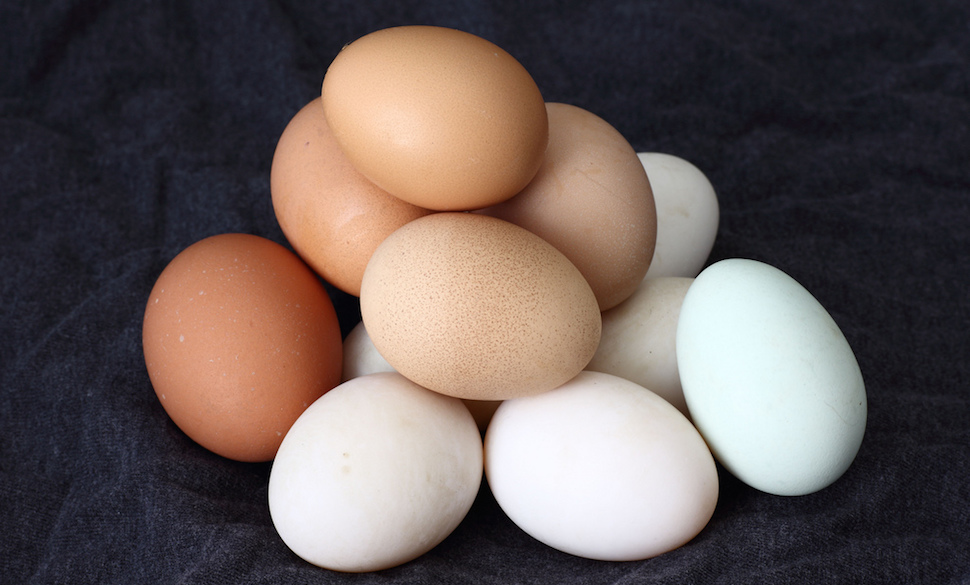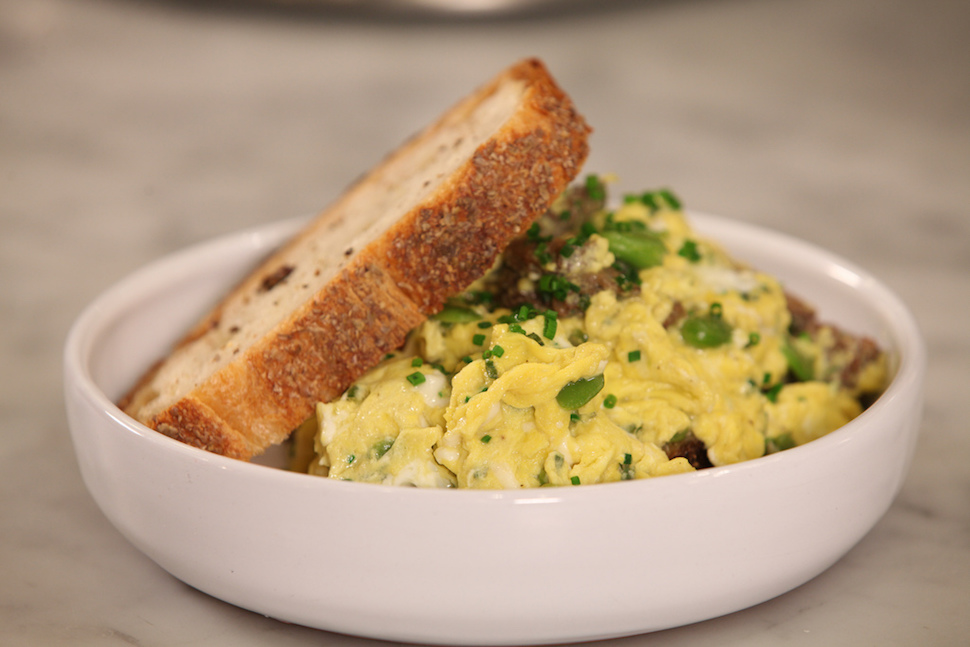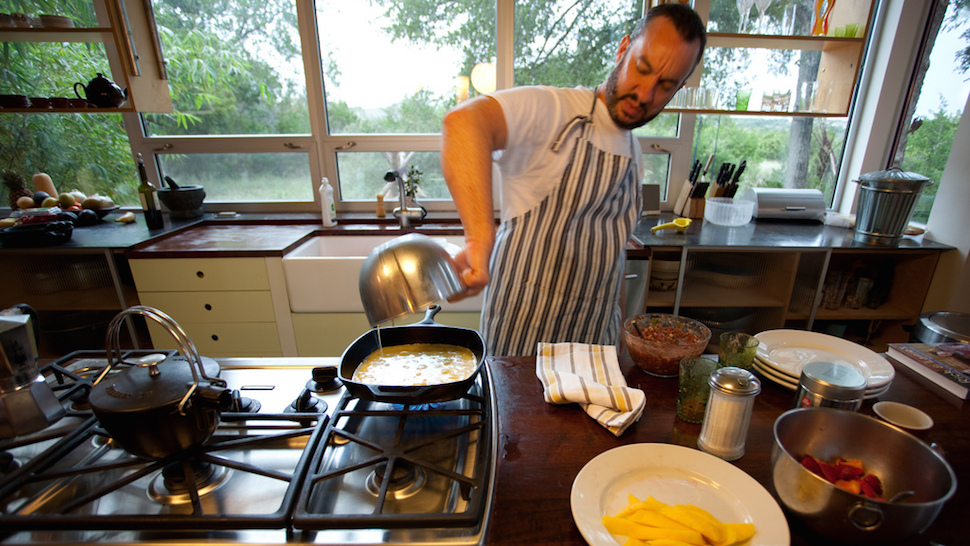Eggs are wonderful. They can be prepared in dozens of ways and used in hundreds of dishes. But they’re deceptively simple to prepare, they’re surprisingly difficult to get right. We sat down with a few chefs to find out what makes eggs so versatile but so difficult, and how you can up your egg game at home.
Title image made using Michele Paccione. Additional photos by John Loo, Breville USA and Lars Plougmann.
Anyone can poach an egg, but there’s a reason chefs spend a lot of time learning how to do it perfectly. Frying an egg looks easy, but that perfect fried egg can be elusive — and it’s easy to screw up at home if you aren’t well-practised. We have entire guides dedicated to better egg cooking, and have posted more egg hacks and tricks than we can count. So why do we love the humble egg so much, and what makes it difficult to master? Much of it boils down to how accessible and versatile the egg is.
Why We All Love Eggs (And Egg Hacks) So Much

Whether you prefer yours fried, scrambled, poached or hard-boiled, there are many ways to approach transforming the humble egg into a delicious dish. And for every preparation method, there’s another whole world of tricks that make it even easier to get from raw egg to your desired preparation. It’s that versatility, both in the number of egg dishes you can make and the number of ways you get there, that make eggs so appealing and interesting.
Chef Shaya Klechevsky, owner of At Your Palate (and frequent Lifehacker contributor) explained that all of those permutations are both a challenge and a blessing:
Eggs are so great because they’re ubiquitous and relatively inexpensive, so there’s room to mess up and not break the bank. Imagine screwing up a piece of aged steak? Re-doing that will cost you a pretty penny, but if you accidentally popped the yolk on an egg, it’s no big deal to scrap it and redo.
I think the biggest challenge around eggs for many people who are not comfortable or confident in the kitchen is that, while it’s extremely versatile, it’s also highly fragile and delicate. Eggs have almost limitless uses: beyond the obvious breakfast foods like omelettes, pancakes, waffles, they are used in many other applications like in cakes and cookies where they lend some richness in their fat as well as in their unique binding ability. When they’re combined with other ingredients like flour and sugar and other liquids in various proportions, they act like a “glue” to hold all the pieces together.
That’s the real beauty of the egg: They’re affordable. We like to experiment with them. Eggs are some of the first foods many of us ever cook on our own. And even though many of us have cooked eggs our entire lives, there are still new and interesting preparations out there waiting for us to discover, and old preparations for us to perfect. Anyone who’s ever made a fried egg and broken a yolk understands this, and anyone who’s ever stumbled on an egg-peeling hack they never imagined knows it too.
Why Eggs Are Remarkably Easy To Make, But Difficult To Master

How someone handles an egg — and what they can transform an egg into — has always said a lot about a chef’s skill. After all, old-school chefs used to ask new recruits to make an omelette — a deceptively difficult task that can tell you a great deal about a new chef’s technical ability and attention to detail. One thing any chef will tell you is that eggs, despite how easy they are to cook, are actually extremely difficult to do well.
When we say “well”, we mean the a poached egg that’s perfectly fluffy around the outside with a smooth, liquid yolk in the middle — the perfect balance between solid and liquid. We mean an omelette that’s still smooth and creamy, but perfectly rolled without being overcooked on the outsides. Once you start really working with eggs, or making eggs that you would hope someone would pay for, the game changes entirely. For example, most of us assume we know scrambled eggs, but as Gordon Ramsay has shown us, and chef Cathal Cavanaugh also demonstrated, what most of us take for scrambled eggs are really more of a “ruined omelette” than anything else — and we like them. When you present someone with a lighter, looser, fluffier scramble, many people are surprised — but that preparation gives you the creamiest, fluffiest texture and the most flavour. Even scrambled eggs — something all of us assume we can do at home — continue to surprise us.
Shaya told us that he knows chefs that have been cooking for decades that still regularly practice and perfect their egg cooking techniques. They try new dishes, discover new preparations and find better ways to poach, scramble, fry and steam. A few years ago, Alton Brown’s baked “hard boiled” egg method (you can watch it in action here) would have been unheard of, but it’s an effective way to cook a lot of eggs perfectly. It’s that spirit of exploration and subsequent discovery that make eggs so difficult to master but make the basics so easy to grasp.
Perfect Your Basic Egg Techniques
The video above is from the PBS Series, “The Mind of a Chef,” specifically an episode in the first season where chef David Chang and friends walk through some of their most interesting egg preparations and tips. Some of them you’ve seen here before, like blowing an egg out of a shell, for example. If you watch, you’ll see some amazing transformations of eggs you thought you knew: light and fluffy scrambled eggs made only with swirling water, a gull’s egg perfectly fried, and even a perfectly soft-boiled egg with caviar and potato chips (dubbed The “Ko Egg”.) Advanced as they are, those techniques are still accessible to home cooks. Here’s what we mean, and how to perfect some simple preparations you may already be familiar with:
- Poached Eggs: Most people will tell you that the perfect poach starts with water that’s just hot enough and a splash of vinegar or bicarb soda (which keeps the whites tight), and a good slotted spoon. Those are great ways to do it, but if you’re looking for an even more foolproof method, America’s Test Kitchen suggest ditching the saucepan for a pan, and using teacups, each with an egg in it, to get that perfect drop into your simmering water. The temperature control you get from a pan makes all the difference, and a little vinegar or lemon juice will help keep the whites tight when you drop them in. Same result or better, and less fuss.
- Hard-Boiled Eggs: There are many different ways to boil the perfect hard-boiled egg, but before you rely on techniques like Alton’s baked eggs, it’s a good idea to master the basics. Our guide to perfectly boiled eggs every time is pretty simple — put cold eggs in a pot, then fill the pot with cold water just enough to submerge the eggs. Put them on medium heat until you get a rolling boil. When the water boils, set a timer for one minute. When the timer goes off, turn off the heat, cover the eggs, move them to a cold burner, and set a timer for 15 minutes. When the 15 minutes are up, the eggs are done. The next trick is peeling them, and there are just as many hacks for peeling hard boiled eggs as there are for cooking them. Feel free to experiment, but the basics work here too — take the eggs out and put them in an ice bath to stop them from cooking. Leave them for a minute or two, but not too long — if you start peeling right away they will be too hot. If you wait, you’ll catch them when the membrane that connects the shell to the white is still warm and loose, but the egg is still soft enough to handle without breaking. Works every time. If you’re adventurous, you could try this feverish shaking method as well.
- Scrambled Eggs: Scrambled eggs appear to be a no-brainer, but they’re tough to get right, mostly because the window of time between them being still near-raw and overly rubbery is a matter of seconds depending on how you cook them. Alton Brown’s method is ideal for beginners. Combine and season your eggs in a bowl (salt, pepper, and some milk for creaminess. Any herbs or spices that develop well with heat will do, too.) Add some butter to a non-stick pan and crank it up to high heat. When the butter is melted and bubbling, pour the eggs directly into the middle of the pan. This pushes the butter out to the sides, which keeps the egg (on the cooler sides of the pan) from sticking. Then start whisking. Keep the eggs moving as they solidify in your pan. When you start to get curds — or soft lumps of scrambled egg — turn the heat down to medium. Start pulling the eggs in from the outside of the pan and folding them over instead of whisking them. As soon as the eggs are mostly solid, cut the heat and transfer them to a plate (preferably a warmed one.) Then let them rest for a minute. The eggs are warm, and they will continue to cook a bit on the plate. This is the big secret to scrambled eggs: Always take them off the heat before they’re how you like them, then let them rest and set up. If you like cheese, you would sprinkle or add it to the pan right as the curds are beginning to form (but before you start folding — you need that leftover heat to melt your cheese.) Once you master that, then you can try Ramsay’s method, or do something crazy like David Patterson’s “Whirlpool Poached Scrambled Egg”, which you can see in action in the video above.
Of course, your own method may differ — maybe you have a different approach you’ve been using all this time, or maybe you have a technique you swear by. That’s fine, but it’s important to try your hand at the basic, most elementary methods before you get too crazy with your own. You’ll learn how to improve your own tricks by learning not rely on them.
How You Can Make Eggs Like A Chef At Home

When you’re ready to perfect your egg game, or you’re inspired by eggs enough that you want to try something new, there are plenty of ways to up your egg-making game. Chef Shaya reminds us first that the most important thing is to experiment. Try, try again, try different preparations, and just don’t stop:
I think the real secret to cooking eggs just comes down to facing and eliminating your fears around them. Accept and then allow yourself to screw up in the beginning, which should then liberate you to have fun and experiment. Growth can only happen from failure, not from constant success. Spark curiosity and experiment.
For the home cook, a lot of this starts with just trying to perfect the dishes you already know how to make. If you like scrambled eggs, examine them when you make them and consider how you can make them better. If you just can’t figure out how to fry eggs without sticking — or without making the edges too crispy — make sure you’re using a non-stick pan, and plenty of butter or oil. Remember too play around in the kitchen — the worst thing that can happen is you have a substandard egg that morning, or you toss it and make another one.
Beyond experimentation, or going to culinary school to learn how chefs handle eggs, here are a couple of great reads that our chefs suggested:
- Egg: A Culinary Exploration of the World’s Most Versatile Ingredient by Michael Ruhlman
- Eggs by Michael Roux
- The Good Egg by Marie Simmons
You can also check out our egg hacks tagpage to see some of the egg prep suggestions we’ve highlighted before. There’s always room to learn and grow. With a little time and energy, you’ll find yourself making fluffy scrambled eggs, light and soft poached eggs, and perfectly fried eggs with minimal effort. Then you can move on to more exciting preparations — or inventing egg hacks of your own.

Comments